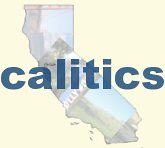"Too Big To Fail" To Fail?
Over the weekend, the White House either released a new part of their regulatory plan or got the AP to bite at its larger intent - that they seek the end of "too big to fail" institutions that threaten to take down the entire economy.
They are the biggest of the big — the Citigroups, the Goldman Sachses, the AIGs and other financial behemoths. The Obama administration doesn't want so many around anymore.
Financial regulations proposed by the president would result in leaner and simpler institutions that don't carry the weight of the system on their marble columns [...]
So far, however, congressional debate has centered on the administration's plan to put the Federal Reserve in charge of these "systemically significant" companies. Less attention has focused on the potential effect on the institutions and the financial system's hierarchy.
Under the administration's proposal, companies such as Citi, Goldman Sachs and others in a broad top tier engaged in complex transactions would face stricter scrutiny and have to hold more assets and more cash as cushions against a downturn.
They also would have to anticipate their own demise, drafting detailed descriptions of how they could be dismantled quickly without causing damaging repercussions. Think of it as planning their own funerals — and burials.
Obama's plan, in short, aims to make it far less appealing to be so big. That was the middle ground the administration sought, a step short of an outright ban on systemically risky companies.
This sounds like a return to the behavioral economics mode that Obama wanted to push going into the White House - in effect, he wants to nudge big institutions from getting so large and interconnected that they must be kept on life support. The rules described here aren't entirely specific, but it sounds like the biggest companies will need to lower their leverage and increase their capital requirements as they grow.
Some believe that eliminating "too big to fail" is impractical. And those beliefs should be taken seriously. But even those critics believe that the way to do it is through capital requirements and leverage. So this is pretty much on the right track.
Now, if the White House takes this advice from the President of the New York Fed, we'd have something.
The Federal Reserve should break with past policy and try to identify and deflate asset bubbles before they can damage the U.S. economy, New York Federal Reserve President William C. Dudley said.
While interest-rate policy may not be the appropriate tool for popping bubbles, Fed officials have "other instruments in their toolbox," Dudley notes in the text of a speech scheduled for July 26 at the Bank for International Settlements in Basel, Switzerland. The New York Fed released his remarks yesterday.
The Fed's view has been that bubbles can be identified only in hindsight, and that all the central bank can do is prepare to clean up after they burst. The current crisis shows that policy is mistaken, Dudley said.
"Asset bubbles may not be that hard to identify," he said. "This crisis has demonstrated that the cost of waiting to clean up asset bubbles after they burst can be very high."
Dudley did not specify what tools the Fed should use. Analysts have suggested that central bankers might raise reserve requirements or amp up restrictions on margin lending.
Simon Johnson links approvingly but wonders if the Fed can actually meet this task.
Of course, if the Fed can’t get better at spotting bubbles, the implication is that no one can. Which means that “macroprudential regulator” is just a slogan – a nice piece of what Lenin liked to call “agitprop”.
And if macroprudentially regulating is an illusion, what does that imply? There will be bubbles and there will be busts. Next time, however, will there be financial institutions (banks, insurance companies, asset managers, you name it) who are – or are perceived to be – “too big to fail”?
You cannot stop the tide and you cannot prevent financial crises. But you can limit the cost of those crises if your biggest players are small enough to fail.
It really all goes back to that. Hopefully the Administration is on the right track.
Labels: banking industry, capital ratios, economy, Federal Reserve, financial industry, leverage, too big to fail






<< Home